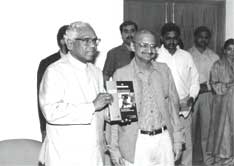Against the haze
 the smog is out of the bag. Slow Murder: The Deadly Story of Vehicular Pollution in India, a Centre for Science and Environment ( cse ) study, was released by the Vice-President K R Narayanan at his residence on November 1. The study exposes the dreadful conditions of Indian metros due to the fatal cocktail released by the ever-growing vehicular craze, amply supported by poor fuel quality, bad vehicular technology and non-existent traffic planning. The Vice-President stressed on inculcating environmental values in our culture.
the smog is out of the bag. Slow Murder: The Deadly Story of Vehicular Pollution in India, a Centre for Science and Environment ( cse ) study, was released by the Vice-President K R Narayanan at his residence on November 1. The study exposes the dreadful conditions of Indian metros due to the fatal cocktail released by the ever-growing vehicular craze, amply supported by poor fuel quality, bad vehicular technology and non-existent traffic planning. The Vice-President stressed on inculcating environmental values in our culture.
According to the study, in Delhi alone the total emissions per day are 2020 tonnes, two-thirds of which is accounted for by vehicular emissions. On November 5, some of the details of the study were presented to a 500-strong audience at ficci auditorium, for a panel discussion chaired by chief election commissioner (cec ) T N Seshan. The panellists included editor of Business Standard , T N Ninan, Delhi assembly leader of the opposition, Jag Pravesh Chandra, Central Pollution Control Board chairperson, D K Biswas, and Supreme Court lawyer, Anil Dewan. The effort was to drive home the hidden fact, in Dewan's words, that "if we don't do anything now, we will not only be fellow victims but also fellow conspirators in murder'.
At the discussion, cse director Anil Agarwal said, "We all want to live like the Americans. But very few of us realise that the western economic dream is actually a highly toxic dream.' He made it quite clear that the average citizen is bearing the brunt of the government's total apathy on the issue.
Quoting from The Cost of Inaction: Valuing the Economy-Wide Cost of Environmental Degradation in India , a study conducted by two World Bank staffers who took the 1993 data on air pollution in Delhi and fed them into a us epidemiological model, Agarwal said that the study revealed 7,491 premature deaths and 3,990,012 hospital admissions. "Although we can argue that the us model is not valid for India, the study can only err on the conservative side, since nutrition levels in India are lower than in the us and, hence, the health impact would be higher.' He urged the people to take the first step in controlling vehicular pollution, "Tell your mp that his or her political career is at stake if this matter is not dealt with expeditiously.'
Most of the panellists felt that the lack of systematic urban development was yet another reason for vehicular pollution. cpcb 's Biswas said that the transport departments at the Centre and in states are not doing their job at all. "There is no proper traffic planning,' he held. Referring to the Mass Rapid Transit System ( mrts), which has been hailed as a viable alternative to surface transport, he said, "Even if the cities are equipped with mrts , majority of the people will still depend on overland transport systems as they cannot afford mrts .'
In this connection, Ninan suggested that a cess should be imposed on private vehicles. "If you were to put two per cent or five per cent tax on the cost of private vehicles, a lot of extra money can be collected which can then be used to finance a public transport system.'
Seshan reminded that expanding cities themselves is a cause of most of the noxious air that we breathe. "There is pressing need to decongest cities. If we go back to Gandhiji's ideal of
Related Content
- Order of the National Green Tribunal regarding dust pollution due to stone crushers at village Tilora, Rausa, Tehsil Mehar, Zilla Satna, Maharashtra, 19/11/2018
- Indonesian Court Rejects Forest Fire Case in Haze Battle Setback
- Indonesia's fires labelled a 'crime against humanity' as 500,000 suffer
- Indonesia orders action against land burning as haze chokes SE Asia
- Haze Fines Win Indonesia’s Support With Caveats: Southeast Asia
- Docs sound caution over dip in mercury, pollution
